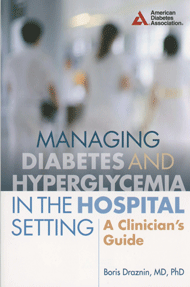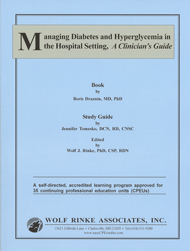| Managing Diabetes and Hyperglycemia in the Hospital Setting, A Clinician's Guide
| C299 |
35 CPEUs |
HARD COPY |
$249.95 |
|
Many clinical outcomes for patients with diabetes and/or hyperglycemia who are admitted to the hospital are influenced by the degree of glycemic control, hence knowledge of the best practices in inpatient diabetes management is extremely important. More specifically you will learn about:
- Insulin errors in the inpatient settings
- Inpatient management of patients with diabetes after bariatric surgery
- Continuous glucose monitoring for inpatients
- Treatment of hyperglycemia on medical and surgical units
Share with a friend and Save! Click here for important information about
sharing.
To order an ADDITIONAL Reporting Form click below:
| C299F |
35 CPEUs |
REPORTING FORM |
$60.00 |

|
Managing Diabetes and Hyperglycemia in the Hospital Setting, A Clinician's Guide
© 2024 Wolf Rinke Associates. All rights reserved for this self-directed accredited learning activity. Reproduction in whole or part without written permission, except for brief excerpts, is prohibited.
LEARNING OBJECTIVES
Upon completion of this CPE activity you will be better able to:
- Evaluate, assess, and manage blood glucose and hemoglobin A1c (HbA1c) values;
- Apply findings from recent research that will assist you to manage medications such as oral and insulin agents;
- Determine therapeutic target blood glucose ranges specific to acuity levels in the inpatient setting;
- Evaluate, assess, and manage patients that present with hypo-and hyperglycemia;
- Recommend treatment regimens for pre-and post-operative patients with hyperglycemia;
- Apply knowledge about the functions and interactions of medication management for hyperglycemia;
- Determine appropriate methods for patients to achieve euglycemia while receiving parenteral or enteral nutrition support;
- Evaluate the hypoglycemic and hyperglycemic risks of medications;
- Calculate insulin to carbohydrate ratios (ICR);
- Formulate the best methods to educate the multidisciplinary team on diabetes management;
- Determine when to prescribe intravenous insulin infusions;
- Calculate insulin regimens;
- Recommend strategies to achieve positive blood glucose management in the post bariatric surgical patient; and
- Determine appropriate content, time frames, and outcomes for the provision of education to health care providers on core diabetes education management.
ABOUT THE AUTHOR OF THE STUDY GUIDE
Jennifer Tomesko, DCN, RD, CNSC is an Assistant Professor in the Department of Nutritional Sciences at Rutgers University in the School of Health Professions. She teaches medical nutrition therapy, nutrition assessment, management, and supervised practice rotation courses for students in the Bachelor of Science in Nutrition and Dietetics Coordinated Program.
Prior to her role in academia Jennifer has worked in acute care for 18 years as a Registered Dietitian, of which 13 years she worked as a clinical nutrition manager. She also provided leadership support and mentoring to new dietitians and managers in the field. Jennifer was an active preceptor and educator in the hospital setting for students and interns.
She obtained her Bachelor of Science in Nutrition and Dietetics at the University of Delaware, Master of Science in Clinical Nutrition at the Indiana University of Pennsylvania, and Doctorate in Clinical Nutrition at Rutgers University. Jennifer completed her dietetic internship at Indiana University of Pennsylvania. She has been a certified nutrition support clinician since 1999, and is actively involved as a board member for the New Jersey American Society of Parenteral and Enteral Nutrition Support Chapter (J.A.S.P.E.N.). Jennifer continues to sit on various committees, and is currently Accreditation Council for the Education of Nutrition and Dietetics (ACEND) Program Reviewer.
If you prefer to order by phone, mail
or fax click below
or click here to contact us with
other questions.
For information about our other products and
services return to the sidebar at the top of the page.
|



